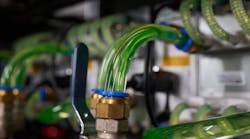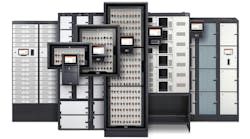Smart Water Conservation for Future Ready Data Centers
For many organizations, reducing water and energy use can feel like a barrier to progress. At Ecolab, we view it differently. Efficiency challenges represent opportunities for innovation.
The rapid expansion of AI is driving unprecedented energy and cooling demand, pushing data centers to rethink their thermal management strategies. New chip architectures and high-density workloads are forcing a shift toward cooling systems capable of handling significantly greater heat loads.
To illustrate the scale of this shift: processing a single query on a leading generative AI platform consumes about 2.9-watt hours of electricity, nearly ten times the power required for a traditional search engine query. Multiply this across millions of interactions per day, and the impact becomes enormous. Some projections estimate that by 2030, the infrastructure supporting advanced AI could require 327 gigawatts of electricity, which is roughly 70 percent of the total power used in the United States in 2024.
Remaining competitive in this environment means investing in advanced cooling solutions paired with digital monitoring tools that improve resource efficiency, enhance performance, and allow operators to adapt quickly to changing loads.
Energy Requires Water
For data centers, it is essential to address both energy and water use for performance and long-term viability.
To help reduce water use, some operators have explored waterless cooling approaches. However, without evaluating the full system's impacts, these strategies can miss two critical realities. First, water cools far more efficiently than air and requires significantly less energy. Second, producing electricity consumes water, which contributes to an unseen but substantial indirect water footprint.
For example, generating 1 MWh of electricity from natural gas requires 570 to 1,100 liters of water before any cooling system even enters the picture. Depending on climate and system design, water cooled facilities typically use 10 to 30 percent less energy than air cooled chiller systems. This advantage is rooted in physics. Water has 3,500 times the heat capacity of air and transfers heat 23.5 times faster.
Even with the thermodynamic advantages of water, it's valuable for data center operators to apply it strategically. Deploying water where it delivers meaningful efficiency gains helps it get managed with precision.
Infrastructure and Digital Monitoring
Smart water management begins well before a data center is built. The planning process must consider climate, water availability, power sources, and local watershed impact. From there, an adaptable cooling topology, often blending multiple cooling methods, is essential for meeting today’s demands and preparing for future ones.
Direct-to-chip liquid cooling, for example, can significantly reduce the load on facility-level cooling systems such as cooling towers and chillers. This lowers both energy and water use across the site.
Once systems are in operation, real time monitoring becomes critical. Each component of the cooling ecosystem must be assessed continuously to maintain performance and catch deviations early.
To put consumption in context, the optimized water use of a 100 MW data center is typically lower than the annual water demand of an 18-hole golf course. However, unlike a golf course, data center water usage can fluctuate hour by hour based on cooling load, incoming water quality, equipment efficiency, outdoor temperature and humidity. Responding to these rapid fluctuations is key to maintaining efficiency and reliability.
Given the speed at which new data centers are being built, no single developer can oversee every cooling related decision from design through operation. Expert partners can manage the entire cooling lifecycle by using data-driven insights to reduce risk, increase reliability, and strengthen both environmental and financial performance.
A Strategic Approach to Water Use
The most effective cooling strategies rely on a holistic and forward-looking approach. This includes understanding local community needs, power grid constraints, and watershed sustainability.
This approach begins with thoughtful site selection that prioritizes regions where water availability, climate conditions and opportunities for free cooling support long term efficiency. During facility design, integrating technologies such as adiabatic systems and direct-to-chip cooling helps reduce electrical demand and improve thermal performance.
Once operational, facilities can pursue water reuse and recycling solutions to reduce dependence on potable water. Digital monitoring further enhances conservation efforts by identifying early signs of system issues and enabling cooling systems to adjust in real time to shifting demands.
Smart water management is ultimately a combination of planning, technology, and continuous optimization. These efforts help data centers meet rising compute demand while minimizing their impact on local water resources.
To learn more, download our latest white paper.
About the Author

Michael Obradovitch
Michael Obradovitch, Esq., Area Vice President of Global Accounts for Ecolab’s data center industry segment, brings over 20 years of experience in engineering, law, and global account leadership, helping data center clients implement scalable water treatment, liquid cooling, and sustainability strategies that deliver measurable ROI.
A global leader in water and process management solutions, Nalco Water, an Ecolab company, works with customers across a wide range of industries to help them address their business goals.



